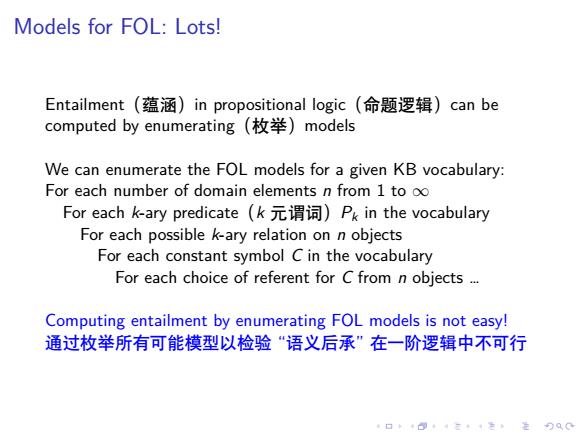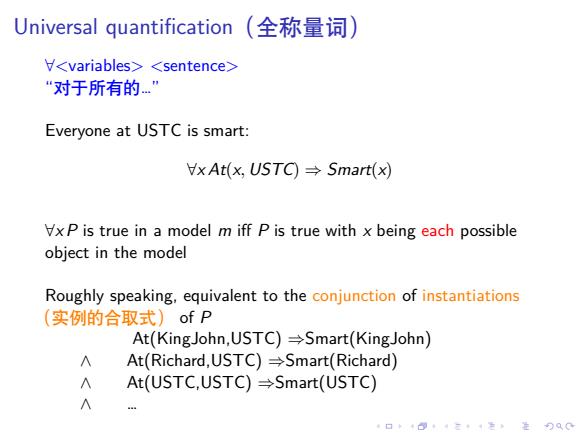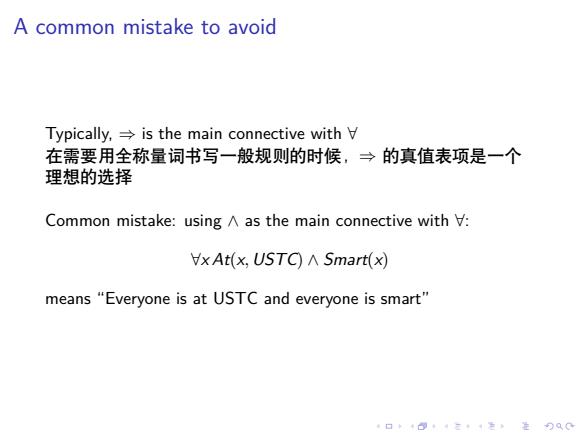
Truth example Consider the interpretation in which Richard->Richard the Lionheart John->the evil King John Brother->the brotherhood relation Under this interpretation,Brother(Richard,John)is true just in case Richard the Lionheart and the evil King John are in the brotherhood relation in the model 口卡回t·三4色,是分Q0
. . . . . . . . . . . . . . . . . . . . . . . . . . . . . . . . . . . . . . . . Truth example Consider the interpretation in which Richard → Richard the Lionheart John → the evil King John Brother → the brotherhood relation Under this interpretation, Brother(Richard, John) is true just in case Richard the Lionheart and the evil King John are in the brotherhood relation in the model

Models for FOL:Lots! Entailment(蕴涵)in propositional logic(命题逻辑)can be computed by enumerating(枚举)models We can enumerate the FOL models for a given KB vocabulary: For each number of domain elements n from 1 to oo For each k-ary predicate(k元谓词)Pk in the vocabulary For each possible k-ary relation on n objects For each constant symbol C in the vocabulary For each choice of referent for C from n objects. Computing entailment by enumerating FOL models is not easy! 通过枚举所有可能模型以检验“语义后承”在一阶逻辑中不可行 日◆4日4三+1=,¥9QC
. . . . . . . . . . . . . . . . . . . . . . . . . . . . . . . . . . . . . . . . Models for FOL: Lots! Entailment(蕴涵)in propositional logic(命题逻辑)can be computed by enumerating(枚举)models We can enumerate the FOL models for a given KB vocabulary: For each number of domain elements n from 1 to ∞ For each k-ary predicate(k 元谓词)Pk in the vocabulary For each possible k-ary relation on n objects For each constant symbol C in the vocabulary For each choice of referent for C from n objects … Computing entailment by enumerating FOL models is not easy! 通过枚举所有可能模型以检验 “语义后承” 在一阶逻辑中不可行

Universal quantification (全称量词) V<variables><sentence> “对于所有的” Everyone at USTC is smart: Vx At(x,USTC)=Smart(x) VxP is true in a model m iff P is true with x being each possible object in the model Roughly speaking,equivalent to the conjunction of instantiations (实例的合取式)ofP At(KingJohn,USTC)=Smart(KingJohn) 入 At(Richard,USTC)=Smart(Richard) ∧ At(USTC,USTC)=Smart(USTC) ∧ 口卡回t·三4色,是分Q0
. . . . . . . . . . . . . . . . . . . . . . . . . . . . . . . . . . . . . . . . Universal quantification(全称量词) ∀<variables> <sentence> “对于所有的…” Everyone at USTC is smart: ∀x At(x,USTC) ⇒ Smart(x) ∀x P is true in a model m iff P is true with x being each possible object in the model Roughly speaking, equivalent to the conjunction of instantiations (实例的合取式) of P At(KingJohn,USTC) ⇒Smart(KingJohn) ∧ At(Richard,USTC) ⇒Smart(Richard) ∧ At(USTC,USTC) ⇒Smart(USTC) ∧ …

A common mistake to avoid Typically,=is the main connective with V 在需要用全称量词书写一般规则的时候,→的真值表项是一个 理想的选择 Common mistake:using A as the main connective with V: xAt(x,USTC)∧Smart(x) means "Everyone is at USTC and everyone is smart" 4口◆4⊙t1三1=,¥9QC
. . . . . . . . . . . . . . . . . . . . . . . . . . . . . . . . . . . . . . . . A common mistake to avoid Typically, ⇒ is the main connective with ∀ 在需要用全称量词书写一般规则的时候,⇒ 的真值表项是一个 理想的选择 Common mistake: using ∧ as the main connective with ∀: ∀x At(x,USTC) ∧ Smart(x) means “Everyone is at USTC and everyone is smart

Existential quantification (存在量词) <variables><sentence> 存在一个这样以致”或“对于某个” Someone at USTC is smart: 3x At(x,USTC)A Smart(x) 3xP is true in a model m iff P is true with x being some possible object in the model Roughly speaking,equivalent to the disjunction of instantiations (实例的析取式)ofP At(KingJohn,USTC)A Smart(KingJohn) V At(Richard,USTC)A Smart(Richard) V At(USTC,USTC)A Smart(USTC) V 口卡4·三4色,是分QC
. . . . . . . . . . . . . . . . . . . . . . . . . . . . . . . . . . . . . . . . Existential quantification(存在量词) ∃<variables> <sentence> “存在一个……,这样以致”或“对于某个……” Someone at USTC is smart: ∃x At(x,USTC) ∧ Smart(x) ∃x P is true in a model m iff P is true with x being some possible object in the model Roughly speaking, equivalent to the disjunction of instantiations (实例的析取式) of P At(KingJohn,USTC) ∧ Smart(KingJohn) ∨ At(Richard,USTC) ∧ Smart(Richard) ∨ At(USTC,USTC) ∧ Smart(USTC) ∨ …